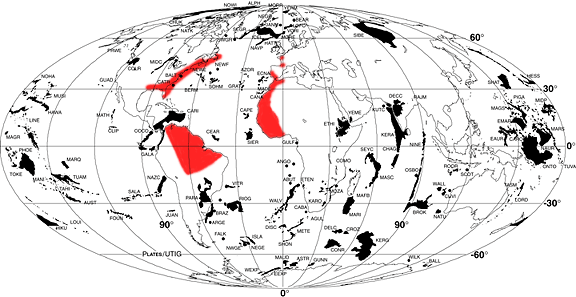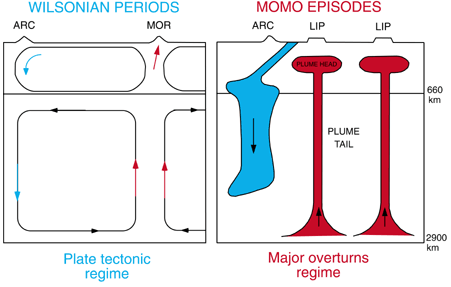
| Previous |
3.3.3. Large Igneous Provinces
Millard F. Coffin, Institute for Geophysics. The University of Texas at Austin, 4412 Spicewood Springs Rd., Suite 600, Austin, Texas 78759-8500
Plate tectonic theory has provided a breakthrough in understanding how the continuous opening and closing of ocean basins reflects convection in the Earthís upper mantle. Among the terrestrial planets and moons of our solar system, however, global plate tectonics may well be unique to Earth. Even on Earth, current plate tectonic theory does not predict major crustal growth events termed large igneous provinces, LIPs (Figure 3.3.3.1). LIPs are a continuum of voluminous magmatic constructions which include continental flood basalts and associated intrusive rocks, volcanic passive margins, oceanic plateaus, submarine ridges, seamount groups, and ocean basin flood basalts. They form in massive volcanic events that result from a mode of mantle convection different from that driving plate tectonics on Earth. Furthermore, unlike the magmatism associated with plate tectonics that creates new crust exclusively in the ocean basins or at ocean margins, LIPs form independently of plate setting; they form on the continents, in the oceans, and along margins between the two, and either wholly within plates or at plate boundaries. The alternative mode of convection manifested by LIPs is probably how other terrestrial planets and moons lose most, if not all, of their interior heat.

LIPs represent enormous outpourings
of predominantly basaltic magma that commonly cover areas of 105
km2 or more. The largest
appear to occur in ocean basins, where giant plateaus such as the Ontong
Java Plateau in the western Pacific and the Kerguelen Plateau in the Indian
Ocean have formed. Similarly, flood basalts were erupted along many "volcanic
passive margins" (e.g., Eastern North America, Greenland, Norway, Brazil,
Namibia, NW Australia) during continental breakup, as well as in continental
settings (e.g., Columbia Plateau in the Pacific Northwest, Deccan in India,
Karoo/Ferrar in South Africa/Antarctica, Parana in Brazil, Siberian in
Asia). Primarily because of ease of access, continental flood basalts are
the best sampled and documented type of LIP. Studies of continental flood
basalts illustrate the evolution in thinking regarding the importance of
such events for Earth evolution. Twenty years ago, when systematic studies
of continental flood basalts began, flood volcanism was largely viewed
as produced by continental rifting - a "standard" plate tectonic interpretation.
Improvements in geochronology, however, have demonstrated that all well-dated
continental flood basalt provinces initially thought to have formed over
many tens of millions of years instead formed, for the most part, in a
million years or less. The rapid melt production rates documented by the
eruption of huge volumes of magma in such short time intervals implies
a generation mechanism other than rifting, since passive rifting cannot
produce such high melting rates. This realization has led to other models
involving either the melting of a plume of hot, mantle that rises to the
surface from a deep thermal boundary layer, such as that between the core
and mantle, or upflow of deep upper mantle in areas where the plate thickness
varies greatly. Neither the initial phase of activity that produces the
LIPs ("plume head") nor the subsequent volcanic activity that commonly
produces trailing volcanic ridges and island chains ("plume tail") in the
ocean basins (Figure 3.3.3.2, below) below are directly related to, or
predicted by, the standard cycle of plate formation, aging, and destruction
described by plate tectonic theory.
| Figure 3.3.3.2: Model of Wilsonian periods and MOMO (mantle overturn, major orogeny) episodes. During Wilsonian periods (left), the normal mode of plate tectonics prevails, with opening and closing of oceans and mantle convection with isolated upper and lower mantle. Plumes originate predominantly from the base of the upper layer, and continental growth is dominated by arc accretion. During MOMO episodes (right), accumulated cold material descends from the 660-knm boundary layer into the lower mantle, and multiple major plumes rise from the core-mantle boundary to form large igneous provinces (LIPs) at the surface, thus creating a major overturn. (After Stein and Hofmann, 994) |  |
The magnitude of such igneous events
is perhaps best illustrated by oceanic plateaus. The Ontong Java Plateau
in the western Pacific, for example, consists of more than 50 million km3
of mafic volcanic and plutonic rocks which form a ~30 km thick plateau
encompassing an area equal to one third of Australia. Events of this magnitude
are unknown to human experience, but the consequences are dramatic. For
example, 1 million km3 of basalt, the size of an average continental flood
basalt province, would bury the area east of the Appalachians from Maine
to Florida under more than a kilometer of basalt. The release of gases
(CO2, SO2,
Cl, F, H2O, etc.)
accompanying such great eruptions must have had tremendous consequences
for the composition of the ocean and atmosphere, with dramatic impact on
climate and environment. Indeed, LIP formation correlates temporally with
ecological changes and extinction of life forms. For instance, the eruption
of the Siberian continental flood basalt province 250 million years ago
at the Permian-Triassic boundary coincided with the largest extinction
of plants and animals in the geologic record. Ninety percent of all species
became extinct at the boundary. Similarly, eruption of the Central Atlantic
Magmatic Province (CAMP) correlates temporally with the Triassic-Jurassic
boundary mass extinctions. On Iceland, the 1783-84 eruption of Laki provides
the only human record of experience with the type of volcanism that constructs
igneous provinces. Although Laki produced a basaltic lava flow which represents
only 1% of the volume of a typical LIP flow, the eruptionís environmental
impact resulted in the deaths of 75% of Icelandís livestock and
25% of its population from starvation. If such a relatively small eruption
happened today, all air traffic over the North Atlantic would likely be
halted for three to six months.
References:
Coffin, M. F., and Eldholm, O., 1994. Large igneous provinces: crustal structure, dimensions, and external consequences, Reviews of Geophysics, 32, 1-36.
Stein, M., and Hofmann, A. W., 1994. Mantle plumes and
episodic crustal growth, Nature, 372, 63-68.
| Previous |